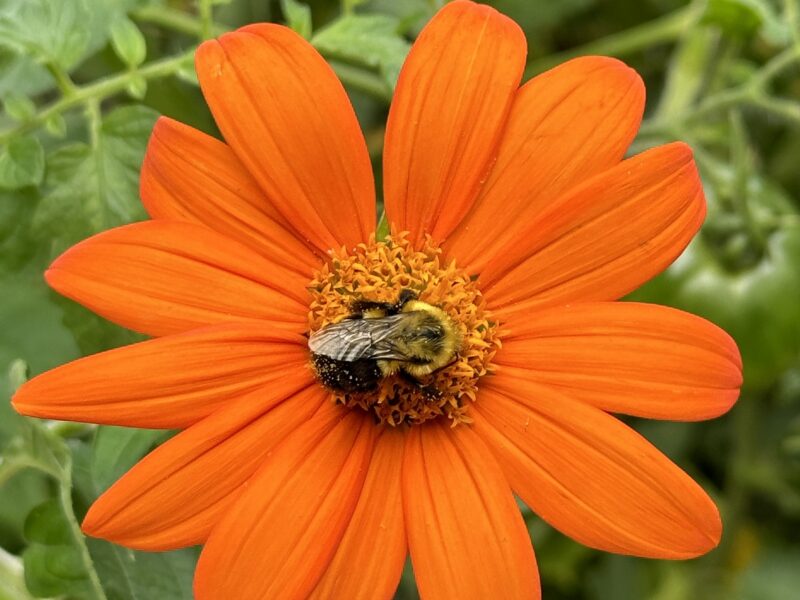

OK, bee lovers, I’ve been taking a hiatus to deal with a rogue hip, but this seemed worth hobbling to my desk to tell you about.
As you already know, honeybees are struggling. Beekeepers in New York State routinely lose about 40 percent of their hives every year. There’s no single cause for that statistic — blame loss of foraging habitat as native vegetation is cleared to build new homes surrounded by pristine, flowerless lawns; Roundup-ready seed stock that lets farmers spray their fields with herbicides that kill flowering weeds that would otherwise sprout up between the rows; or well-meaning homeowners who douse their yards in toxic chemicals to ward off ticks and mosquitoes when a nontoxic spray of lavender oil can be just as effective and far safer, not just for the birds and bees but for pets and children as well.
One particularly awful cause of honeybee demise is the widespread use of a class of neurotoxins called neonicotinoids. Neonics, as they’re commonly called, have already been banned in Europe, and some states in the U.S., including New York, have passed laws restricting their use for most lawn and garden use.
In June, the New York State legislature went a big step further, passing the Birds and Bees Protection Act, which would make it illegal in most cases for farmers to use neonic pesticide sprays on crops or to use seeds precoated with the pesticide.
The bill, which would go into effect on January 1, 2027, has been waiting for Governor Kathy Hochul’s signature, while she weighs the pros and cons of passing such a ban. On its face, it seems an easy decision — choose in favor of a healthy environment.
But a local farmer I spoke with recently said the issue is actually far more complex. Neonics were introduced as a “softer” chemical alternative to other pesticides that ruled the market prior to their arrival. And although this farmer doesn’t use them, he explained that a farmer can drizzle imidacloprid, one of the several neonics named in the bill, on seed potatoes as they’re being planted and eliminate the problem of potato bugs. Not only does the farmer get a better, stronger harvest, but he doesn’t have to use aerial spraying of other pesticides to keep potato bugs at bay while the spuds are growing, and that means less airborne poison for pollinators, such as bees and butterflies, and other wildlife to deal with.
Unfortunately, neonics have turned out to have a dark side in the form of neurological issues. For honeybees, this means that foraging bees exposed to the chemicals can lose their internal GPS, so they can’t find their way back to the hive after they go out foraging. With a large enough exposure, that depletes the hive stock to unsustainable levels and the hive dies.
Because honeybees are basically livestock, we can easily see the effects of neonics on their well-being. But it’s safe to assume that other insects suffer similar neurological effects from the chemicals. It’s probably no coincidence that the rusty-patched bumblebee, a native pollinator, is now on the endangered species list. Neonics remain active in plants and in the soil for months, or even years, and because they are in the fruits and vegetables, not on the surface, they can’t be rinsed off, so they end up in our diet as well, including in honey.
Studies have linked neonics to health issues in humans, including muscle tremors, lowered testosterone levels and altered insulin regulation. They’re finding their way into tap water as well, making it ever harder to avoid them.
According to the New York Senate bill, a 2020 study by Cornell University found that the routine use of neonicotinoid-treated seeds “does not consistently increase net income for New York field corn or soybean producers,” and “neonicotinoid-treated corn and soybean seeds do not consistently increase expected net income compared to untreated seeds,” but “at the same time, widespread use of neonicotinoid-treated seeds incurs risks for insect pollinators.”
If the neonic ban becomes law, even with the exceptions it includes for farmers who can’t find an adequate supply of seeds not pretreated with the chemicals, there will be a significant reduction of these neurotoxins ending up in our environment. But farmers will then be forced to turn back to other pesticides that are damaging in other ways. None of these chemicals are risk-free.
Many farmers do their utmost to minimize the damage these chemicals can cause. My friend, for example, uses the pesticide Sevin to avoid harming pollinators — but never on anything that has flowers. I doubt many large-scale commercial farms are as cautious, but as long as we have a society dependent on commercial farming to keep billions of nonfarmers fed, our choices are limited.
We’re lucky to have farmers on the East End who keep the health of our community top of mind. Their families live here too, so the issue is personal. Re the issue of neonics, as my farmer friend noted, “Everything in life is a trade-off.”
You can read the Birds and Bees Protection Act here: nysenate.gov/legislation/bills/2023/S1856/amendment/A
If you’d like to weigh in, you can contact Governor Hochul’s office directly here: governor.ny.gov/content/governor-contact-form
 More Posts from Lisa Daffy
More Posts from Lisa Daffy